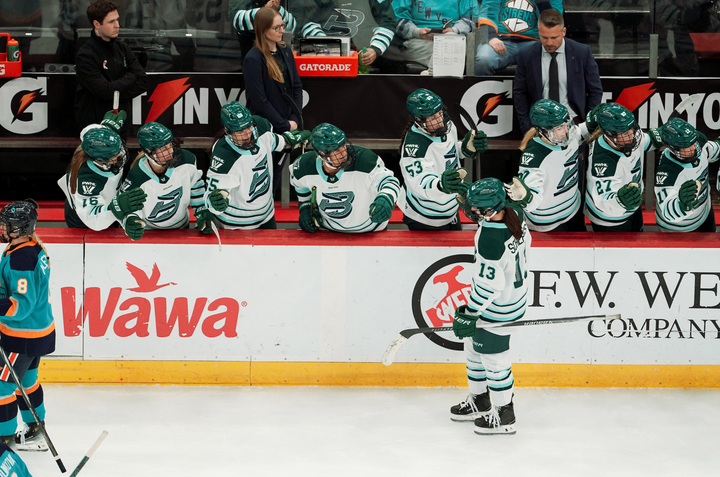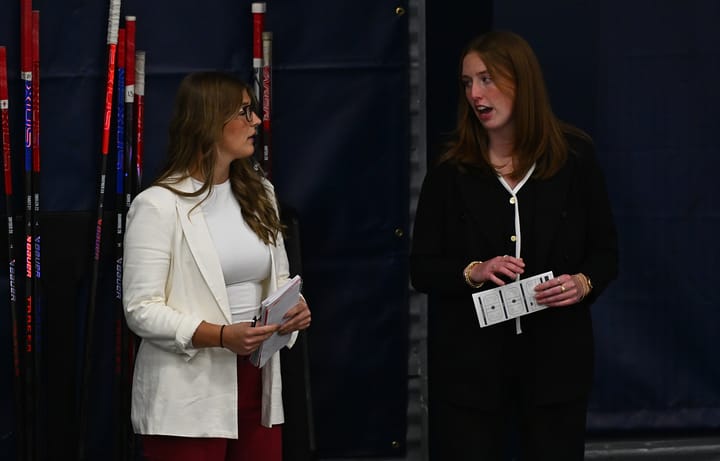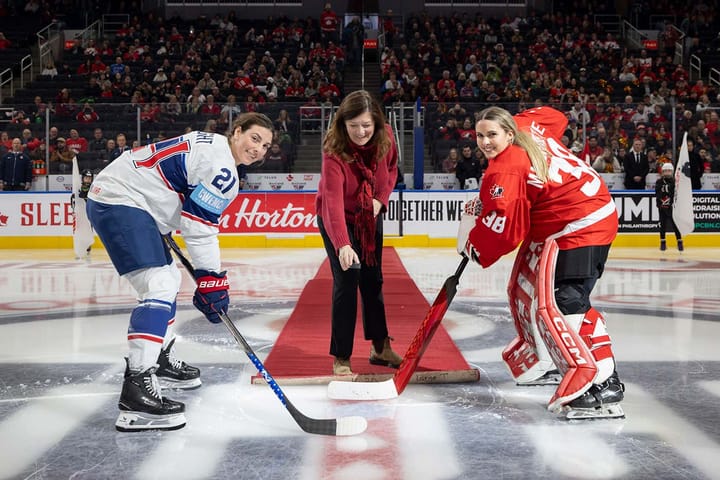Wicked Angles Book Hour: “As Fast As Her” by Kendall Coyne
The U.S. Olympian gets a little too ahead of herself with the preach factor in this memoir of her hockey experiences.
I know context is everything, and Twitter provides exactly none of it, but I promise you: when I started reading this book I did not go into it with a pessimist’s mindset.
A story in two parts. pic.twitter.com/wF7OhiTpRO
— angélica rodríguez 🏳️🌈🏒🇵🇷 (@ReinaDeLaIsla) August 3, 2022
Oops.
Anyway, Kendall Coyne wrote a book that got published earlier this year, and it’s called “As Fast As Her: Dream Big, Break Barriers, Achieve Success,” and really that tagline tells you everything you need to really know about this book. Heavy on the “words of wisdom” and fairly light on introspection (funnily enough), Coyne espouses on her upbringing in Illinois, her training alongside boys’ teams and her path to Team USA. Over the 200-plus pages of 1.5-spaced lines, I soon realized that much of what the intended demographic for this book might consider sage advice, I simply have long glimpsed past as style over substance.
So who is this book for?
When I stumbled across this book on the shelves at Barnes & Noble, I was surprised not just to see it there, but to see it in the Young Adult Nonfiction section. Now obviously there’s nothing wrong with YA (after all, what the hell was I doing there? Looking for good books, of course), but when it comes to athlete biographies, there are plenty I can think of off the top of my head that take up their rightful spot in the Sports section, with titles like One Life by Megan Rapinoe getting a “young readers’” abridged version. So this was a deliberate choice, or so it seems, by Coyne and the publishing house that took in her tome to market this to a younger audience.
It makes sense to an extent, I suppose, since a lot of women’s hockey player narratives still involve the “little girls in the stands” aspect of having a platform on national TV and in mainstream media. But it’s also problematic for reasons I will get into in just a bit.
First, the positives.
What works about this book?
Pretty much all of the stuff that comes from Kendall herself, as in Kendall the person (not Kendall the Role Model For Young Girls Everywhere Across the United States). She talks at length about her family, and the stories she has about them (especially her brother) are entertaining and sweet. It’s obvious she has a great relationship with them all, and the anecdotes at the beginning in particular (about her childhood) stand out. Toward the beginning, for example, there’s a gross yet funny visual where Kendall talks about going to her brother Kevin in their Jack-and-Jill style bathroom and demanding he help her pull her baby teeth out so she didn’t have to deal with them: “Even though I complained about the pain and it sometimes got bloody, he had no problem with this big brother task.”
There’s also a great story around page 27 where Kendall attended a hockey camp specifically for girls, held by Cammi Granato. The way she talks about being able to bond with other hockey-playing girls for the first time after spending so much of her time playing on boys’ teams is touching, as is her description of being able to learn from Cammi herself and the emphasis on representation in hockey being able to inspire the next generation.
Another high point is the advice that comes midway through the book surrounding adolescence, school, and balancing academics and athletics as well as the pressure to fit in. All of this is bound to resonate with the target audience, especially when too many of them are still trying to deal with the stigma placed on them for being “too much” of something — too loud, too fast, too driven, too athletic, too tomboyish. That “too much”-ness is something I myself have felt at various points in my young adulthood into my mid-to-late 20s, and it’s something I’ve slowly learned to embrace as a strength, rather than try to stifle. Having someone as high-profile as Coyne reinforces that definitely has a great effect.
What needed editing?
I’m sorry, but whoever was in charge of those “Golden Coyne” tidbits throughout the chapters needs to put down the damn Pinterest. Every time I saw one, I cringed at the page, because none of them (save for maybe one or two) was truly unique to Coyne. After some stories that you could tell were truly hers to tell, it just felt generic and canned. You could have lost 97 percent of them and lost nothing from this book that really mattered all that much.
There’s also this really disingenuous bent to the idea of working hard to achieve success. I have absolutely no doubt that Coyne worked her ass off to get to where she is today. You don’t have her kind of resume without busting tail and getting results. But the entire premise that success is solely the product of effort, and if you’re not getting where you want to be, you probably aren’t working hard enough, is quite frankly as old as Jaromir Jagr and not even half as impressive. We should have been long past this point of thinking all we need to do is haul ourselves up by our bootstraps, but here we are.
And now... to my main gripe (or gripes, if you will) about this book.
Check yourself before you check others — either on or off the ice
Throughout the book, Kendall talks about her family not having a lot of money and “scraping” to pay for hockey for their kids, but they also built two houses from the ground up in a nice suburb of Chicago and put four kids — four! — through sports. No doubt everyone’s idea of “struggle” is relative to their surroundings, but I’m not about to pretend I can identify with this. After all, having to buy store-brand food isn’t quite the same as having main utilities cut off, facing eviction, and having to take buses and walk to school and work after losing a family vehicle. (And yes, these are all things my family has dealt with.)
One chapter that really got under my skin was when Kendall talked about being heartbroken that she was only getting a partial scholarship to Boston University, not a full ride, and how she knew she was worth a full athletic scholarship. I have no problem with the message that you should know your worth and fight for it, but... well, this hit close to home, and here’s why.
BU was my dream school especially after I got into hockey. I wanted nothing more than to attend a college with a good J-school and a great hockey program I could get involved with, and I was in love with the idea of going to the same school as one of my favorite hockey players at the time, Rick DiPietro (don’t judge). That said, at the time, applying to BU not only cost a fee, but required both the regular SAT and SAT Subject tests, and of course, each time you took a test it was an additional fee. The accumulated cost was likely going to be well into the $100-200 range just for one school, and while I’d always been a strong student and involved in a lot of things, of course, there’s no guarantee of admission.
My parents had to be the ones to tell me in no uncertain terms that they couldn’t afford and weren’t going to pay for me to apply to the only school I ever wanted to go to, and without any clear guidance as to how I could get assistance, I had to watch that dream slip away. Because of money. So when I read this whole sob story about Kendall not getting “all” the money she felt she was worth, I had to put down the book and remind myself of the perspective — but any younger reader who might have faced the same things I have is probably not going to be able to do that as easily.
All in all, it’s obvious that there are quite a few privileges Coyne has failed to check in the writing of this memoir, and that puts a damper on the whole thing for me at least. Then again, given her past comments about Colin Kaepernick and his movement against police brutality, should I really be surprised?
Professional for who — for everyone, or just you?
There’s also the common refrain from plenty of National Team and other PWHPA players evident in this book: “there is no professional hockey league for women in North America.” Oooooh, boy.
Anyone who reads mine and my colleagues’ work on TIG or even sees our posts in passing knows the Premier Hockey Federation has plenty of problems. No one is under any delusions that what the PHF does is close to flawless, and in fact you can take a look at my column backlog for more information on that. But pretending no professional league exists in its purest form does nothing for women’s hockey, it does nothing for the hundred-plus players who get paid doing what they love, and it does nothing for your own cause in attempting to create something better.
This could have been a great opportunity to outline Coyne’s specific issues with the pro league that we do have here and talk about what she wants to achieve with the PWHPA. She could have illustrated that as a prime example of seeing a structure and working to change it, and highlighting former NWHL/PHFers working to do just that. Instead, we have the PW operating in some sort of weird vacuum against something she’s simultaneously pretending isn’t a thing to begin with. So which is it?
As Fast As... who again?
Lastly... the book is called “As Fast As Her.” But Coyne spends so much of the book talking about how she worked and played in comparison to boys’ teams, talking about the importance of playing against them and keeping up with them, and making it sound like even now in the 2020s the only way to succeed is to keep up with men. That is blatantly untrue.
I can appreciate that in the 90s and 2000s, many girls had to play with and against boys in order to elevate their game. I also can relate to Kendall’s own fight for her own place in hockey — I’ve been writing about this hypermasculine sport since the age of 16, and I’ve dealt with my fair share of misogyny and unfair standards along the way. But I’m under no presumption that we need to compare ourselves to the guys anymore.
No longer do we have just one choice, one way of competing. There are so many examples of amazing women’s hockey players these days who are strong and talented players in their own right, not just compared to their male counterparts. Coyne’s focus on the guys does such an injustice to all of those players as well as herself, because who honestly gives a damn about what the guys are doing anymore? She’s helped lay the groundwork for pro and amateur women’s players both. Focus on that, not whether or not you’ve worked to earn the respect of a bunch of Neanderthals.
All in all, this is a book that probably wasn’t meant for me, and it feels like it. There are some highlights and plenty of lowlights, and overall I just felt like I didn’t gain a whole lot for it. Maybe some young players will read it and feel much differently, but I only hope they know they don’t necessarily have to follow Kendall’s same path just to be as fast as her.





Comments ()